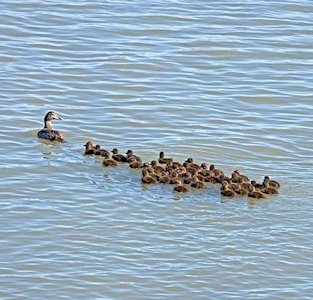
|
Bird's Patterns of Chick Development -- Page 4
Precocial
development does, however, impose some limitations. It is well suited
mainly to species that nest on the ground and feed on foods that can be taken
by chicks on the ground or on water. For many songbird species that forage on
insects in treetops, or for hawks and owls, which kill relatively large prey,
precocial chicks would still be unable to feed themselves. Furthermore,
precocial chicks must accomplish much more development than
altricial
chicks
while still in the egg, which means that females must lay large eggs and spend
more time incubating them in a vulnerable, ground nest site.
Altricial
birds shift more of their parental care effort into the post-hatching stage.
Many
precocial
waterfowl chicks are even better equipped to avoid predators because they can
swim almost from birth.
|
| Duck and Brood | |
| ⇦ Back to Chick Development - Page 3 Return to Bird Nesting Choices On to Chick Development - Page 5 ⇨ | |